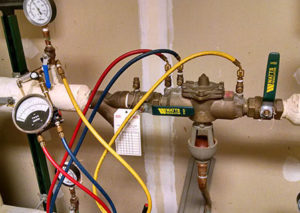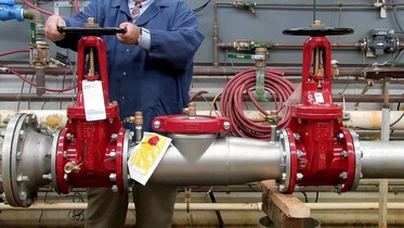Should I Conduct a Backflow Test on My Water System?
Should I Conduct a Backflow Test on My Water System?
Blog Article
Do you find yourself trying to find help and advice on Backflow Prevention?

Yes, you need to backflow test your home's water system to make sure that the water is free of contaminants and hazardous degrees of chemicals. As a result of the equipment needed and space for error, you ought to not attempt to do backflow screening on your own. We recommend that you call a professional plumber every number of years to check your water.
Backflow Can Effect Both You and also Your City
Several cities establish backflow standards because harmful heartburn can impact the public water along with a solitary building. Contemporary cities have backflow gadgets in location that protect the water supply that comes from a lot of houses and industrial properties. The genuine risk comes from irrigation systems, which can damage the water with hazardous fertilizers, manure, as well as various other chemicals.
What Creates Backflow?
A typical source of backflow is a loss of water pressure that causes the water to siphon back right into the water. An instance is cleaning out a paint bucket making use of a tube. You fill up the paint pail up with water, leaving the pipe in the bucket. After time, there is a loss in water pressure and also the pipe begins to draw the water back right into the water system. As you can envision, there are now chemicals from the paint that are entering the water, possibly positioning a risk. Numerous people are not even conscious of backflow screening, but there are many reasons why it's so crucial.
Heartburn Testing is Required by Regulation in Particular Cities
Relying on where you live, you might in fact be required by law to backflow test your regulation. Iowa City keeps a document of all residential properties served by the city's water supply. The city needs that particular "high-hazard" facilities go through heartburn screening. In some cases, homes such as houses as well as apartment are impacted.
You Can Protect Against Heartburn
Hazardous heartburn is conveniently avoidable if you have a specialist plumber install a heartburn device. If there is an active risk, the plumber will certainly also check for backflow as well as establish. The main purpose of a heartburn gadget is to stop water from moving in reverse right into your supply of water. Plumbing technicians set up the device on the pipelines in your residence to ensure that the water only moves in the correct instructions.
What is Heartburn?
In short, heartburn is when water moves upwards-- the opposite direction in the plumbing system. This is additionally referred to as "backpressure." When the water moves in this instructions, it can blend with harmful toxins as well as posture a danger.
Call a Plumber to Evaluate for Heartburn Prior To It is Far too late
A plumbing firm can rapidly test your home's water to figure out if there are any dangerous chemical degrees. As well as if you do uncover that your water has high levels of toxic substances, a plumber can quickly mount a heartburn avoidance gadget.
Yes, you require to backflow examination your residence's water supply to guarantee that the water is free of toxic substances as well as hazardous levels of chemicals. Numerous cities establish heartburn guidelines since hazardous heartburn can influence the public water supply in addition to a solitary structure. A normal reason of backflow is a loss of water pressure that triggers the water to siphon back right into the water supply. After some time, there is a loss in water stress and the hose begins to suck the water back into the water supply. The major purpose of a heartburn device is to protect against water from flowing backwards right into your water supply.
WHY DOES BACKFLOW TESTING NEED TO BE DONE EVERY YEAR
What Is Backflow?
Toxic gas backing up into a building is one example of potential backflow issues, but backflow can occur in many other ways.
Backflow is generally referred to as the reversal of a liquid or gas in a plumbing system.
Most issues for the public occur with backflow resulting in contaminated drinking water. If you look up backflow issues online you’ll probably find references to “potable” water. That means drinking water.
There have been backflow issues in the past with drinking water. Chemicals, sewage and other contaminants have found their way into drinking water causing health issues for those that count on the fresh water.
What Causes Backflow?
In a residence or commercial building water generally flows one way. This normal flow is usually driven by consistent pressure in the water and waste system.
Anything that changes the normal pressure in the system can lead to backflow.
Fire hydrant use or malfunction can reverse the normal pressure in the system on a city line, but backflow can occur in a number of different ways.
Sometimes backpressure might be caused by someone using a garden hose and submerging the end of the hose in a pool of liquid. If pressure is lost the flow could reverse and contaminants could be released into the drinking water.
Anytime there is a connection between contaminants and the drinking water there is potential for a backflow issue. Sometimes these connections are not immediately obvious like the garden hose connecting to a building’s drinking water supply.
Backflow Regulations
The Environmental Protection Agency (EPA) provides guidelines and regulations for state and local governments regarding backflow. State and local governments also have their own guidelines and regulations for backflow prevention.
Arizona has its own backflow regulations.
Due to issues with backflow in the past, regulations require backflow preventer devices to be used in nearly all residential and commercial buildings.
A backflow preventer is a device that prevents backflow as cross-connection points where potential backflow issues may occur.
While backflow is not a common occurrence, preventers are in place to make sure there is no contamination should something malfunction or go wrong with a building’s water supply.

We had been made aware of that report on Backflow Assembly Testing from someone on another site. For those who enjoyed reading our blog posting kindly don't forget to pass it around. We recognize the value of reading our article about Backflow Assembly Testing.
Go Services
Report this page